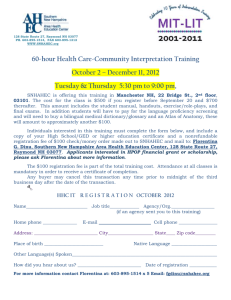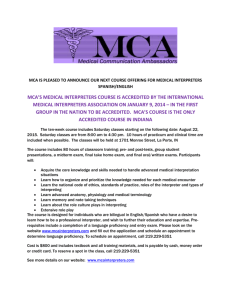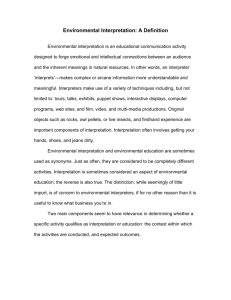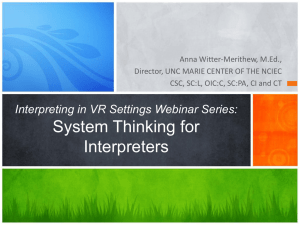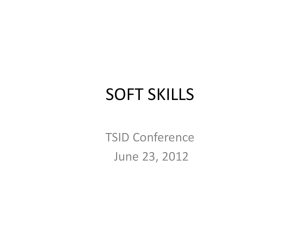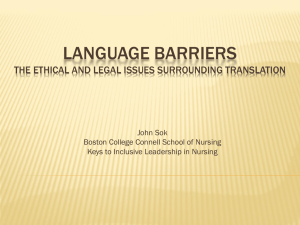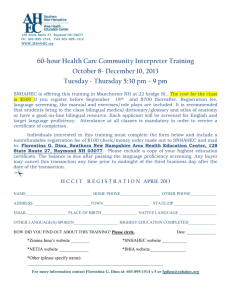Damon Timm
advertisement
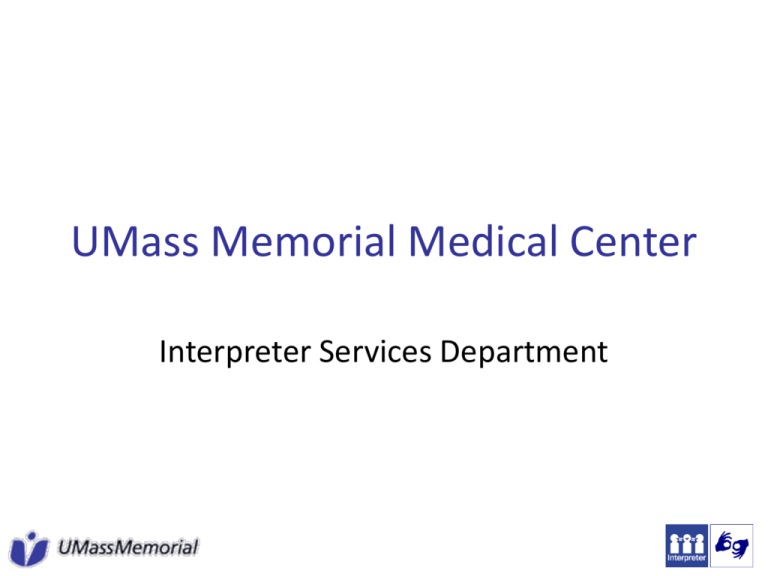
UMass Memorial Medical Center Interpreter Services Department UMass Memorial Medical Center • Three campuses and medical school • Medical Center Statistics (Worcester): – – – – – Licensed Beds: 771 Employees: 9,610 Hospital Admissions: 40,013 E.D. Visits: 128,250 Ambulatory Department Visits 689,954 Interpreter Services Department • • • • Director of Interpreter Services: 1.0 FTE Coordinator of Education, Training, and Translations: 1.0 FTE Office Support Staff: 2.35 FTE Staff interpreters: 28.4 FTE (Albanian, ASL, Chinese, French, Portuguese, Spanish, Russian, Vietnamese) • Independent Contractors: 40+ interpreters (ASL, Albanian, Amharic, Arabic, Bengali, Cambodian, Chinese Mandarin, Chinese Cantonese, Farsi, French, Haitian Creole, Greek, Guyarati, Hindi, Hmong, Italian, Korean, Polish, Portuguese, Russian, Spanish, Somali, Swahili, Twi, Tigrinya, Urdu, Vietnamese) Interpreter Encounter Totals FY 02 FY 03 FY 04 FY05 FY 06 FY 07 Forecast FY 08 Spanish 25552 36358 42244 36827 37232 43471 48697 Portuguese 4954 6177 6526 7262 7640 9594 9992 Vietnamese 3492 3865 3800 3459 4104 5250 6087 Albanian 1879 2795 2643 2822 3109 3667 3482 ASL 1064 720 841 921 1601 1770 1862 "Other" 4462 4731 5403 5682 5944 6333 6125 Total Volume 41403 54646 61457 56973 59630 70085 76155 Interpreter Encounter Totals 80000 75000 70000 65000 60000 55000 50000 45000 40000 35000 30000 FY 02 FY 03 FY 04 FY05 FY 06 FY 07 '08 - Est. How We Started 1988 1. Formation of an “ Affirmative Action Committee on services to LEP patients” •Findings: Organization Com •Interpreters (bilingual staff) were not trained or compensated •Services were not monitored on quality or confidentiality. •Limited resources to meet the demand 2. Community Language skills survey was distributed 1991 • UMMMC Interpreter Services department is formed. 1989 1..Formation of an IS Task Force. 2. Complaint to the DHHS, OCR. based on country of origin and language • ISO director •Advisory Group subcommittee •Policies and procedures 3. DON for a new outpatient bldg: •Training program •Acknowledged UMMC ethical and legal obligations to LEP patient • Job descriptions 1999 Merger of UMass Medical Center and Memorial Hospital Centralization of administrations and operations Standardization of policies and procedures •Recommends establishing a professional ISO, recruitment of bilingual staff and translation of hospital forms and signs. •Creation of IS Advisory Group Sub-committee Diversity of com languages Basic Workflow of Department • Identify Need for Interpreter • Schedule Future Appointments – Face-to-face interpretation – Telephonic interpretation • Manage Same-Day Requests – Onsite dispatchers handling live schedule • Document Interpretation – Database & Medical Record Identifying Need for Interpreter • Patient’s language, and need for an interpreter, are required fields in the registration process • Information is consistently collected at point of registration or inpatient admission • Information becomes part of the patient’s electronic admissions data and medical record (available In IDX scheduling system) Future Request Forms Appointments Linked in IDX Same-Day Requests • Business Hours: – – – – Two dispatchers Interpreter floaters Page/call system Direct Access to Telephonic Interpretation • After-Hours: – Answering Services – On-site & on-call interpreters – Direct Access to Telephonic Interpretation Just-in-Time Interpretation Strategies • • • • • • Providing just-in-time access to language services Eliminates cost of interpreters delay Meets increasing demand Complements on-site resources Meets needs of patient centered organization and open access Discourage use of unqualified interpreters Tools • • • • Optimal equipment Direct access to an outsourced vendor Advance scheduling with vendor Advance notification to departments Data as Catalyst to Quality • The Encounter Form – – – – – Location Date/Time Providers Informed Consents Admission/Discharge • Data Entry (Statistics) • Medical Record Recent Performance Measures From the RWJ “Speaking Together” Collaborative • ST-1: Percentage of patients who have been accurately screened for their preferred languages • ST-2: Percentage of patients receiving language services from qualified interpreters or bilingual providers • ST-3: Percentage of encounters where patient wait time for an interpreter is 15 min or greater • ST-4: Percentage of time interpreters spend providing medical interpretation in clinical encounters • ST-5: Percentage of encounters where interpreters wait ten minutes or more for providers Data Examples How Data Helps Prove the Point Telephonic Interpretation Increased 270% Increase from Apr ’07 to Apr ‘08 1400 1200 1000 800 600 400 200 0 Nov'06 Feb'07 May'07 Aug'07 Nov'07 Feb'08 May'08 Before Roll-Out After Roll-Out Night-Shift Interpretations What a difference an on-site interpreter makes! 250 200 150 100 50 0 Nov'06 Feb'07 May'07 Aug'07 Nov'07 Feb'08 May'08 Aug'08 On-Call Interpreter On-Site Interpreter Case Study for ASL: Scheduled Appointments at Maximum 110 105 100 95 90 85 80 75 70 Case Study for ASL: Same-Day Requests Continue to Increase 50 45 40 35 30 25 20 15 10

